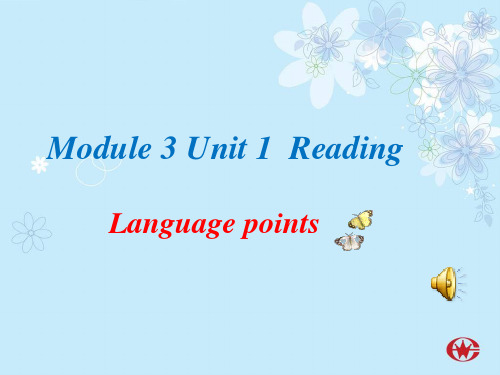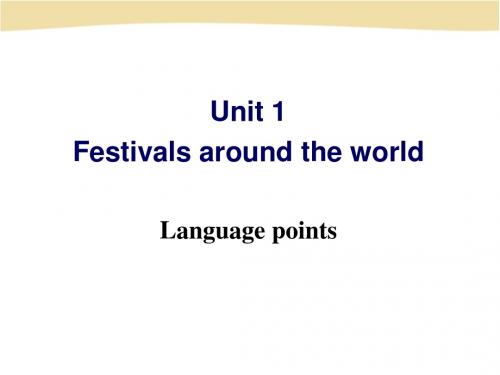M3U1 languagepoints 2
- 格式:doc
- 大小:49.00 KB
- 文档页数:2



八年级上册英语m3u1知识点在八年级上册英语中,Module 3 Unit 1是关于“Travel by train”的内容,下面是该单元的核心知识点。
1. 表达乘火车旅行的词汇及短语:train station - 火车站platform - 站台ticket office - 售票处ticket - 票one-way ticket - 单程票return ticket - 往返票timetable - 时间表departure time - 出发时间arrival time - 到达时间seat - 座位2. 用英语表述火车票的购买:How much is a one-way ticket to London? - 一张去伦敦的单程票多少钱?Can I have a return ticket to Paris, please? - 我想要一张巴黎来回的票。
What time is the first/last train to Manchester? - 去曼彻斯特的第一班/最后一班火车什么时候?Can I reserve a seat? - 我能预订座位吗?3. 用英语表述火车的时刻表:What time does the train leave/arrive? - 火车几点出发/到达?What platform does the train leave from? - 火车从哪个站台出发?4. 表达路线和方向的词汇及短语:north - 北south - 南east - 东west - 西The train is going north/south/east/west. - 火车往北/南/东/西开。
5. 表述旅行活动的词汇及短语:sightseeing - 观光tourist attraction - 景点guide - 导游map - 地图camera - 相机souvenir - 纪念品6. 熟练运用简单的交通指令:Excuse me, how do I get to the train station? - 对不起,请问怎么去火车站?Take the bus number 10 and get off at the train station. - 乘坐10路公交车,在火车站下车。

外研七年级英语上册M3U1教学设计Analysis of the whole module:Theme: School informationFunction: Describing a schoolStructure: There be structure; How many+there be; prepositions of places (in, on,behind, near)Module task: Describing your schoolModule 3 My schoolUnit 1 There are thirty students in my class.Ⅰ. Analysis of the textWhat:Unit 1 contains two listening materials. In the short listening, a girl student is introducing her classroom (including the number of students and the facilities in the classroom). In the long listening, Daming and Linda are asking and answering each other about what their classrooms are like.Why:The purpose of this unit is to let students take a careful look at their classroom and know how to ask and answer information about it in English. Also, students will get to know what the classrooms are like in other places orcountries. In the process, students will better know and cherish the environment in which they live and study every weekday.How:-The short listening introduces a classroom through monologue while the long listening introduces a classroom through dialogue (asking and answering questions).- There be structures are used to introduce or ask and answer questions about a classroom.- Prepositions such as in, on, behind, next to and in front of are used to indicate places.Ⅱ. Analysis of studentsWhat they knew:Students have learned simple words and expressions about classroom and places in primary school. Also, they have preliminary understanding of there be structure at the time.What they wonder:They may wonder how to ask and answer questions about classrooms or introduce their classroom in English. Also, they may wonder what the classrooms are like in foreign countries and what attitude they should take to theirs.What they will learn:They will learn to ask and answer questions about classrooms or introduce classrooms by using there be structure and prepositions of places. Also, they will get to know what the classrooms are like in foreign countries. In this process, they will understand what attitude they should take to the learning environment in which they live and study every day.Ⅲ. Teaching AimsBy the end of this lesson, students will be able to:1. match the picture with the listening material.2. acquire detailed information about classrooms from the listening.3. ask and answer questions about classrooms by using there be structure.4. take a look at the classrooms in other countries and form a right attitude to theirs.Ⅳ. Key Points and difficult pointsKey points:1. new words and phrases about classrooms.2. the two listening material.Difficult points:1. there be structure and Wh-questions.Ⅴ. Teaching MethodsActivity-based Teaching Approach Cooperative Approach Situational Language TeachingⅥ. Teaching AidsPPT Blackboard ChalkⅦ. Teaching StepsStep 1: Warming up1. Greetings between teacher and students.2. Play a video called What’s in your new classroomfor students.3. Free talk:①What is the song about?②What can you remember about the song?③Are there any other things in your classroom?Step 2: Pre-listening1. Show pictures of our classroom and learn new words and expressions.2. Play a game: Tell me your number.3. Complete A6 on P15.4. Practice the new words and expressions in the sentence pattern:How many... are there in our class? (pay attention to furniture)Step 3. While-listening1. Listen and choose the correct picture in A1. (A2 on P14)2. Listen and try to find the correct answer.⑴In Linda’ school there are 30 / 46 students in a class.⑵In Daming’s class there are 25 / 20 girls.⑶There is / isn’t a computer on Linda’s teacher’s desk.⑷Are there any pictures in Daming’s classroom?Yes, there are. / No, there aren’t.⑸ Are there a map of t he world in Linda’s classroom?Yes, there are. / No, there isn’t.4. Listen again and complete the table. (A3 on P15)5. Check answers by using the following sentence patterns:How many... are there in ...’s class?Are there any pictures on the classroom wall?Is there a map of the world in ...’s class?6. Read after the recording. (Imitate the pronunciation and intonation.)7. Read together.8. Read the dialogue by roles.Step 4. Post-listening1. Listen and repeat. (A5 on P15)2. Listen and repeat the numbers. (A6 on P15)3. Pair work: Ask and answer questions about our class. (A7&8 on P15)4. Language points.Step 5: Summary and Homework1. Summary:①New words and phrases.②Sentence patterns.2. Homework:① Practise English writing.② Finish the exercises of M3U1 on reference book.Ⅷ. Blackboard Design。


高中英语M3U1知识点回顾Words & Expressions for Unit 1 Words: sense hold one’s fear(hold one’s hand)rest (on her arm) hear my heart beating lead sb. through sth.keep their hands in very hot wateras…as possible尽可能take the pain承受痛苦stay healthy保持健康experiment in做…...的实验;experiment on在......做实验experiment with用......做实验do / make / carry out / perform the experiment….. Phrases1. as well也,还2. not…until直到…才…3. make great achievements取得成就4. l ost one’s sense失明in sight看见out of sight看不见catch sight of看见lose sight of看不见at the sight of一看见5. be covered in被笼罩在…..中be covered with / by 覆盖着6. step out走出去step in/into走进step over横越, 跨过step up走近; [美]促进, 加紧make astep forward[backward]前进[后退]一步step aside走到一旁step by step逐步地, 循序渐进地7. the rest of 其余的,其余部分8. glance at匆匆看一下take / have a glance at9. set off (for) 出发set out (for)10. by the time到…为止11. wish for=look forward to期盼;盼望12. reach out伸出reach for取13. stare up at抬头凝视着14. (say sth.) in one ear15. watch out for留心注意keep a watch onwatch out 当心,小心look out (for); take care (of)be careful (of)16. get across越过,通过17. follow one’s advice听从某人的建议18. be related to与…有关19. be linked to与…有关;与…联系20. be in a position to do(处于状态)有办法/有可能做某事21. lie in在于22. find one’s way out找出…出路23. make sense讲得通,有意义24. have something to do with与…有关25. late on = later以后26. rather than而不是;宁愿27. turn down调小28. can’t help doing sth.情不自禁做某事29. warm up热身30. get close to逼近31. turn around四周环顾32. be frozen with由于…呆了33. sweat with fear吓出汗了34. all of a sudden = all at once =suddenly35. ring out36. in the distance在远处37. at the beginning ofAt the end ofIn the middle of38. set sail for启航39. be through经历Reading(P2-3)Read the text carefully and answer the following questions to help you understand the text further.1. What did Polly get to know from the weatherman?A. It was going to rain.B. There would be strong wind.C. There would be a thick fog in the afternoon.D. There would be no buses at the bus stop in the afternoon.2. Why did she walk quickly towards her usual bus stop?A. She wanted to get a seat on the bus as it was crowed.B. She wanted to know if there was a bus.C. She had something urgent (紧急的) to deal with.D. She felt she would get wet as it was going to rain.3. Who might the tall man in a dark coat be in your opinion?A. the old blind man.B. the bus conductor.C. a robber.( 强盗)D. one of his colleagues.4. Why did the man brush Polly’s face?A. He did it on purpose. (故意地)B. He was blind and he didn’t know there was someone in front of him.C. He wanted to ask her to go away.D. He wanted to help Polly go along the street.5. On sunny days, how can the blind like the old man get across the road?A. They can manage it without any help.B. The have a special road to take.C. Some workers are arranged specially (专门地) to help them.D. Many warm-hearted people would like to offer their help.Module 3 Unit 1Language points (P1-5)1.confuse vt. –to make someone feel that they can’t think clearly or don’t understand别告诉我这么多,-- 你把我弄糊涂了。